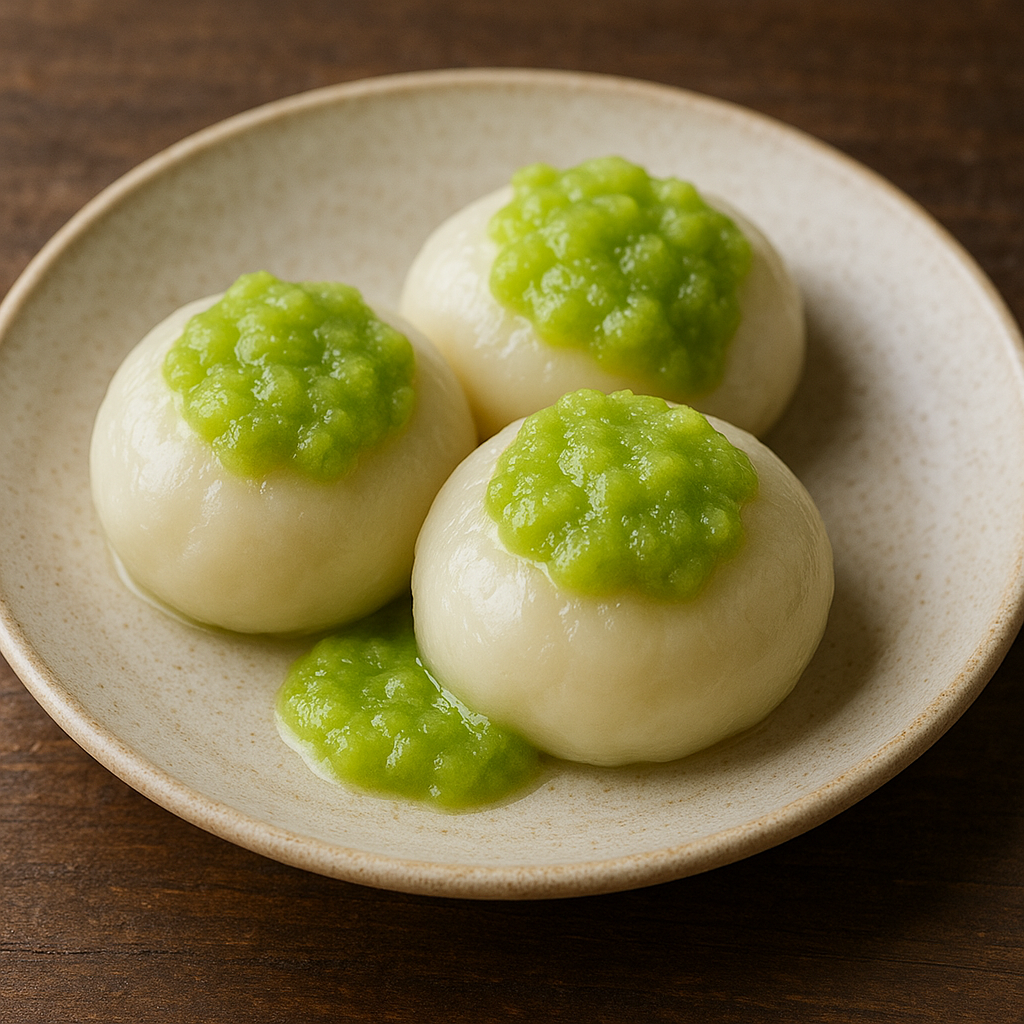ずんだ餅(宮城)の特徴
枝豆の香りと粒感を活かした、東北を代表する“青あん”の餅菓子です
ずんだ餅は、ゆでた枝豆をすりつぶして砂糖と少量の塩で調えた「ずんだ餡」を、つきたての餅にからめていただく宮城の郷土菓子です。枝豆の甘い香りと青々しい色、ほどよい粒感が魅力です。
粒度と甘じょっぱさで“我が家の味”に
餡は粗つぶ〜なめらかまで好みで調整します。砂糖の量や塩の当て方、ゆで汁でのばす濃度によって口当たりが変わり、家庭ごとの味わいが受け継がれています。
ずんだ餅(宮城) レシピ
材料(5人分・小餅10個目安)
- もち米 … 2合(約300g)※市販の切り餅でも可
- 枝豆(さや付き) … 600g(正味むき豆 約200〜230g)
- 砂糖 … 40〜80g(好みで)
- 塩 … ひとつまみ
- (濃度調整)枝豆のゆで汁 … 大さじ2〜4
作り方
- 枝豆を塩少々(分量外)で2〜3分下こすりし、流水で洗ってからたっぷりの湯で色よくゆでる。冷水に取り、さやから出して薄皮をむく。
- むき豆をすり鉢(またはフードプロセッサー)で好みの粒度にする。砂糖・塩を加え、ゆで汁で“落ちる程度”にのばしてずんだ餡にする。
- 餅:もち米を蒸してつく、または切り餅をゆで(または焼き→湯通し)して柔らかくする。10等分に丸める。
- 餅が温かいうちにずんだ餡を絡める(または上にたっぷりのせる)。
シェフのワンポイントアドバイス
- 薄皮は外すと色・口当たりがクリアに。粗つぶを残すと香りが立ちます。
- 甘さは砂糖40gから少しずつ加減。塩は“甘さを締める量”にとどめるとバランス良好です。
- 餡が固いときはゆで汁で調整。仕上げは餅が熱いうちに絡めるのがコツ。
栄養価(1人分の目安)
- エネルギー … 260〜380 kcal
- たんぱく質 … 8〜13 g(枝豆・餅由来)
- 脂質 … 4〜9 g
- 炭水化物 … 45〜60 g
- 食物繊維・ビタミンB群・葉酸 … 枝豆由来
歴史
“豆打(ずだ)”の所作が語源とされます
ゆでた大豆・枝豆を打って(すって)餡にする「豆打(ずだ)」が訛って“ずんだ”になったという説が広く語られ、東北各地で親しまれてきました。
ハレの日と日常のおやつに受け継がれてきました
新豆の季節や彼岸・盆のもてなしに供され、粒度や甘じょっぱさの塩梅に家の個性が宿ります。宮城では土産菓子としても定着し、四季を問わず楽しまれています。
English Version
Features of Zunda Mochi (Miyagi)
A signature Tohoku rice cake with fragrant, lightly textured edamame “green paste”
Zunda Mochi coats freshly pounded mochi with zunda—a paste made by crushing boiled edamame and seasoning with sugar and a pinch of salt. The sweet, green aroma, vivid color, and gentle nibble of the beans are the charm.
Texture and sweet–salty balance make every household’s style
Choose your preferred grind—from rustic to smooth. The amount of sugar and salt, plus how much you loosen the paste with cooking liquid, all shape the mouthfeel and flavor passed down at home.
Zunda Mochi (Miyagi) – Recipe
Ingredients (Serves 5; about 10 small mochi)
- Glutinous rice … 2 go (≈300 g) ※ store-bought kirimochi is fine
- Edamame (in pods) … 600 g (yields ≈200–230 g shelled beans)
- Sugar … 40–80 g (to taste)
- Salt … a pinch
- (To adjust) Edamame cooking liquid … 2–4 Tbsp
Directions
- Rub edamame pods with a little salt (not listed) for 2–3 minutes, rinse, then boil in plenty of water until bright green. Shock in cold water, shell, and peel the thin skins.
- Grind the beans in a suribachi (or food processor) to your preferred texture. Add sugar and salt, then loosen with a little cooking liquid until the paste just falls from the spatula.
- Mochi: Steam and pound the glutinous rice, or soften kirimochi by boiling (or grill then dip briefly in hot water). Divide into 10 balls.
- Coat the warm mochi generously with the zunda paste (or spoon the paste over the top).
Chef’s Tips
- Removing the thin skins gives a brighter color and smoother finish; leaving some coarse bits boosts aroma.
- Start with 40 g sugar and adjust; keep salt minimal to sharpen sweetness without dominating.
- If the paste is too stiff, adjust with a little cooking liquid; coat the mochi while hot for the best adhesion.
Nutrition (per serving, approx.)
- Energy … 260–380 kcal
- Protein … 8–13 g (from edamame & mochi)
- Fat … 4–9 g
- Carbohydrates … 45–60 g
- Dietary fiber, B vitamins, folate … from edamame
History
Likely derived from “zuda”—bean-pounding into paste
A common explanation traces “zunda” to “zuda” (to pound/turn beans into paste). The treat spread widely across Tohoku.
A staple for festivals and everyday snacks
Served for new-crop celebrations and during equinox/Bon hospitality, zunda’s grind and sweet–salty balance showcase each family’s taste. In Miyagi it is also a beloved souvenir sweet enjoyed year-round.



何でも質問してください!